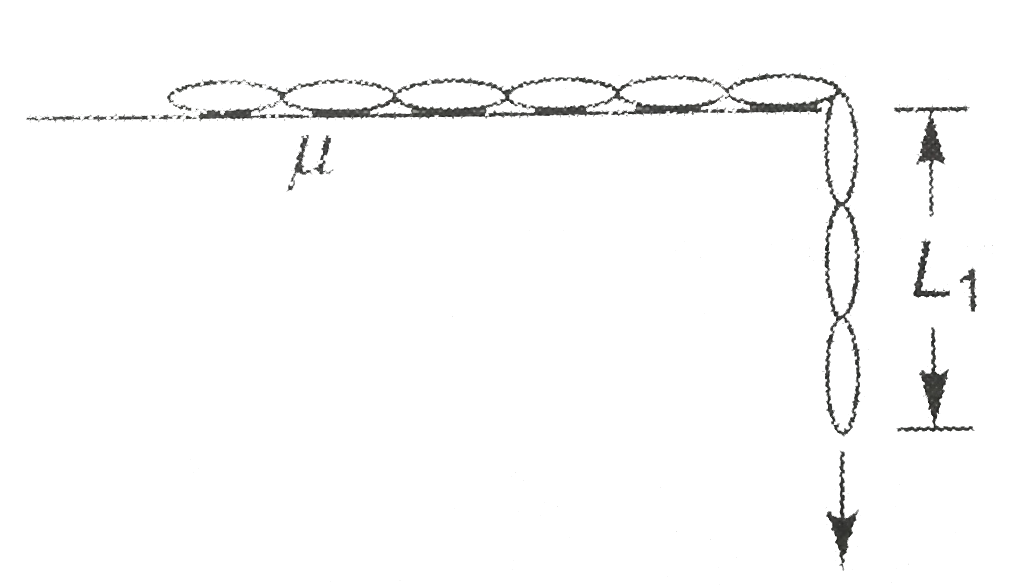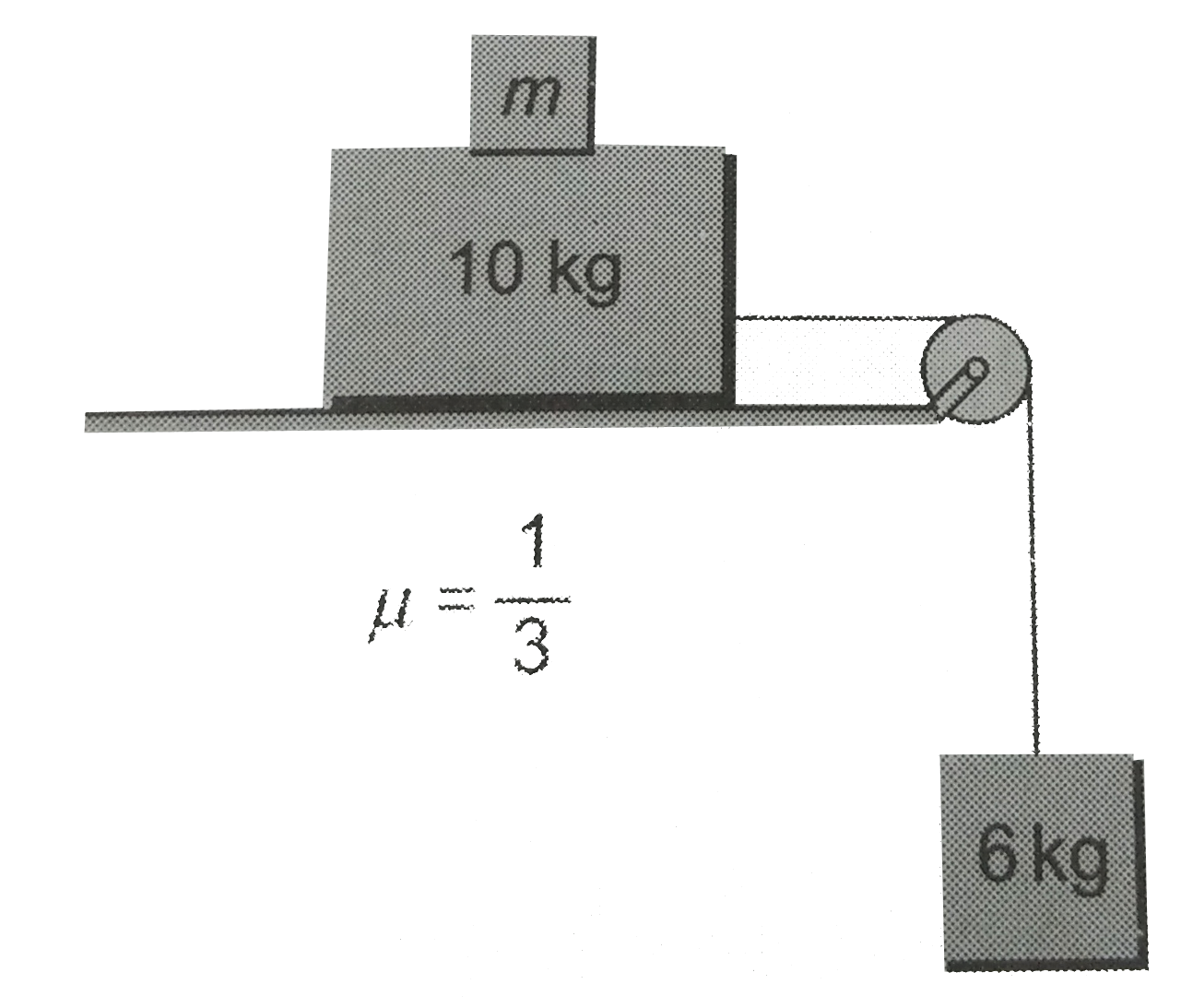A uniform rope of length l lies on a table if the coefficient of friction is , then the maximum length l, of the part of this rope which can over hang from the edge of the table without sliding down is -
lμ
lμ+1
μlμ+1
μlμ−1
The correct Answer is:c
To solve the problem of determining the maximum length X of the part of a uniform rope that can overhang from the edge of a table without sliding down, we can follow these steps:
1. Define Variables:
- Let the total length of the rope be L.
- Let the length of the rope hanging over the edge be X.
- The length of the rope on the table will then be L−X.
- Let λ be the mass per unit length of the rope.
2. Calculate the Mass:
- The mass of the hanging part of the rope is given by:
mhanging=λX
- The mass of the part of the rope that is on the table is:
mon table=λ(L−X)
3. Determine Forces:
- The gravitational force acting on the hanging part of the rope is:
Fgravity=mhanging⋅g=λXg
- The maximum static friction force that can act on the rope to prevent it from sliding is:
Ffriction=μ⋅mon table⋅g=μ⋅λ(L−X)g
4. Set Up the Equation:
- For the rope to remain at rest, the friction force must be equal to the gravitational force acting on the hanging part:
λXg=μ⋅λ(L−X)g
5. Cancel Common Terms:
- We can cancel λg from both sides (assuming λ≠0 and g≠0):
X=μ(L−X)
6. Rearrange the Equation:
- Rearranging gives:
X+μX=μL
- This simplifies to:
X(1+μ)=μL
7. Solve for X:
- Finally, we can solve for X:
X=μL1+μ
Conclusion:
The maximum length X of the part of the rope that can overhang the table without sliding down is:
X=μL1+μ
- Let the total length of the rope be L.
- Let the length of the rope hanging over the edge be X.
- The length of the rope on the table will then be L−X.
- Let λ be the mass per unit length of the rope.
- The mass of the hanging part of the rope is given by:
mhanging=λX
- The mass of the part of the rope that is on the table is:
mon table=λ(L−X)
- The gravitational force acting on the hanging part of the rope is:
Fgravity=mhanging⋅g=λXg
- The maximum static friction force that can act on the rope to prevent it from sliding is:
Ffriction=μ⋅mon table⋅g=μ⋅λ(L−X)g
- For the rope to remain at rest, the friction force must be equal to the gravitational force acting on the hanging part:
λXg=μ⋅λ(L−X)g
- We can cancel λg from both sides (assuming λ≠0 and g≠0):
X=μ(L−X)
- Rearranging gives:
X+μX=μL
- This simplifies to:
X(1+μ)=μL
- Finally, we can solve for X:
X=μL1+μ
The maximum length X of the part of the rope that can overhang the table without sliding down is:
X=μL1+μ
Topper's Solved these Questions
Similar Questions
A homogeneous chain of length L lie on a table. If the coefficent of friction is μ , find the maximum length L1 of the chain which can hang from the edge of the table without the chain sliding down.
(b) Consider the situation as shown in the figure. Find teh minimum value of m so that the blocks do not move.

 View Solution
View SolutionAssuming the length of a chain to be L and coefficient of static friction μ. Compute the maximum length of the chain which can be held outside a table without sliding.
View Solution
Knowledge Check
- Question 1 - Select One
A uniform rope of length l lies on a table. If the coefficient of friction is μ, then the maximum length L of the part of this rope which can overhang from the edge of the table without sliding down is
AlμBlμ+1Cμl1+μDμlμ−1 - Question 2 - Select One
A uniform rope of length l lies on a table . If the coefficient of friction is μ , then the maximum length l1 of the part of this rope which can overhang from the edge of the table without sliding down is :
A1μB1μ+1Cμlμ+1Dμlμ−1 - Question 3 - Select One
A uniform rope of ≤n>hLmeters is lying over a table. If the coefficient of friction be μ, then the maximum length L1 of the part of the rope which can overhang the edge without sliding is
AμL(μ+1)B(μ+1)μLCμL(μ−1)D(μ−1)Lμ
Assuming the length of a chain to be L and coefficient of static friction μ. Compute the maximum length of the chain which can be held outside a table without sliding.
View SolutionIf the coefficient of static friction between a table and a uniform massive rope is μ, what fraction of the rope can hang over the edge of a table without the rope sliding.
View SolutionA heavy uniform chain lies on horizontal table top. If the coeficient of friction 0.25, then the maximum friction of length of the chain that can hang over on edge of the table is
View SolutionA homogoneous chain of length L lies on a table. The coefficient of friction between the chain and the table is μ. The maximum length which can hang over the table in equilibrium is
View SolutionA heavy uniform chain lies on horizontal table top. If the coefficient of friction between the chain and the table surface is 0.25, the maximum percentage of the length of the chain that can hang over one edge of the table is
View Solution

